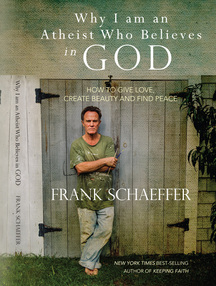
As the reputation of Christianity has been deformed once in a while we should take a look at the real thing. Mother Maria is the real thing. As she wrote: “Christianity demands of us not only the mysticism of communion with God, but also the mysticism of communion with man.”
Chapter 25 WHY I AM AN ATHEIST WHO BELIEVES IN GOD: How to give love, create beauty and find peace (Excerpt)
“Mother Maria of Paris is a saint of our day and for our day; a woman of flesh and blood possessed by the love of God.” So wrote British intellectual and Orthodox bishop Harold Bloom. Born to a prominent Russian Orthodox family, Mother Maria (then Elizaveta Pilenko) renounced her religious beliefs at age fourteen when her father died. She later became a committed atheist and Bolshevik. In 1910 she married and was drawn to both literary and leftist revolutionary circles, divorcing in 1913. The anti-communist White Army took control of her town and tried her as a communist, but the judge was a former teacher of hers and Mother Maria was acquitted. The two fell in love, had an affair and eventually married.
Mother Maria and her husband fled Soviet Russia, arriving in Paris in 1923. By then she was studying theology and doing social work among impoverished Russian exiles. After her second marriage dissolved, she had an illegitimate child. Mother Maria began her journey back to Christianity, explaining, “Christ also died. He sweated blood. They struck his face.” But her faith was messy. She didn’t have the outward appearance of holiness and she was the sort of person good people avoided. In Paris her Orthodox bishop—aware of her work on behalf of the poor and also keenly aware of her failed marriages—encouraged Mother Maria to take vows, which she did only with his promise that she would not have to live in a convent. So she became a nun because of a bishop who allowed her to dictate terms.
Scandal!
In 1932, Mother Maria took the monastic Christian name Maria and turned her rented house in Paris into a hybrid commune/homeless shelter/intellectual/theological salon/food pantry/bar rolled into one. She drank! She chain smoked! She ate meat during Lent! She never denounced or converted the debauched intellectuals and artists of Paris who were her friends!
As Jerry Ryan wrote in a review of Mother Maria Skobtsova: Essential Writings, “Many were scandalized by Mother Maria. This woman had been twice divorced, had an illegitimate child by another man, had leftist political sympathies and was an eccentric. At her becoming a nun she took the name of Maria in memory of St. Mary of Egypt, a prostitute who became an extreme crazed ascetic.”
As Ryan notes, Mother Maria continued to scandalize. Her clothes were filthy with grease from the kitchen and paint from her workshop. She stank. She frequented bars, had no patience with long Orthodox liturgies, and found strict ascetic fasts impossible to keep. Any self-respecting bishop would have kicked her out. She was the wrong kind of nun. As Olivier Clement writes in the preface toRyan’s book.
If we love and venerate Mother Maria it is not in spite of her disorder, her strange views and her passion. It is precisely these qualities that make her so extraordinarily alive among so many bland and pious saints. Unattractive and dirty, strong, thick and sturdy, yes, she was truly alive in her suffering, her compassion, her passion.
Mother Maria dismissed people like me who were preoccupied with their spiritual lives and so-called personal relationships with God. She would probably have dismissed most of this book as self-indulgent. According to her, my sort of spiritual narcissism must be abandoned if one hopes to truly love as Jesus loved. Mother Maria wrote:
In our time Christ and the life-giving Holy Spirit demand the whole person. The only difference from state mobilization is that the state enforces mobilization [to care for people], while our faith waits for volunteers. And, in my view, the destiny of mankind depends on whether these volunteers exist and, if they do, how great their energy is, how ready they are for sacrifice.
Mother Maria said that Christian egocentrism is a contradiction in terms. In her essay “Types of Religious Life,” she denounced the Orthodox Church’s institutional structures, rituals, even aesthetic beauty, as dead ends. She also dismissed “trends of social Christianity… based on a certain rationalistic humanism [that] apply only the principles of Christian morality to ‘this world’ and do not seek a spiritual and mystical basis for their constructions.”
After the fall of France to the Germans and after the collaborationist Vichy government required Jews to wear the yellow star, Mother Maria wrote this poem entitled “Israel.”
Two triangles, a star,
The shield of King David, our forefather.
This is election, not offense.
The great path and not an evil.
Once more in a term fulfilled,
Once more roars the trumpet of the end;
And the fate of a great people
Once more is by the prophet proclaimed.
Thou art persecuted again, O Israel,
But what can human malice mean to thee,
who have heard the thunder from Sinai?
Jews came to Mother Maria begging for Christian baptismal certificates in order to escape deportation. To help them was to risk death, but Mother Maria took in Jews and gave them forged documents declaring them non-Jews. Her house was soon bursting at the seams. Mother Maria once remarked, “It is amazing that the Germans haven’t pounced on us yet.” If anyone came looking for Jews, she said, she would show them an icon of the Mother of God.
A children’s book I read to Lucy, Silent as a Stone, St. Maria of Paris and the Trash Can Rescue, tells the story of Mother Maria saving Jewish children. Her home was near the cycling stadium of Vélodrome d’Hiver, where the Jews were held on their way to deportation. The book is based on firsthand accounts of what Mother Maria accomplished during her visits to that stadium in June of 1942. As those who had been rounded up awaited deportation to the camps, Mother Maria used her status as a nun to bring food to the families waiting for transport. Then she smuggled some of their children out of the stadium in trashcans under the guise of helping with sanitation. The hygienic Germans allowed this, never suspecting that each trash can had a small terrified child huddled inside. Those children often became the only survivors in their families.
Mother Maria risked everything for the very people who in Russia had often been persecuted by anti-Semitic Orthodox. Then, on February 8, 1943 the Germans arrested Mother Maria, her son, Yuri, her priest, Father Dmitri, and their helper, Elia Fondaminski.
Father Dmitri was interrogated by Hans Hoffman, a Gestapo officer. A portion of the interrogation has been preserved, as transcribed by the ever meticulous Nazis.
Hoffman: “If we release you, will you give your word never again to aid Jews?”
Father Dimitri: “I can do no such thing. I am a Christian and must act as I must.”
Hoffman:(striking the priest across the face.): “Jew lover! How dare you talk of helping those swine as being a Christian duty?”
Father Dimitri: (holds up the crucifix from his cassock): “Do you know this Jew?”
Mother Maria was sent to the Ravensbrück concentration camp. Prisoners who survived have shared some of their memories: “She exercised an enormous influence on us all,” wrote one survivor after the war. “No matter what our nationality, age, political convictions—this had no significance whatever. Mother Maria was adored by all. The younger prisoners gained particularly from her concern. She took us under her wing. We were cut off from our families, and somehow she provided us with a family.”
One account of Mother Maria’s martyrdom says that on Easter Saturday, 1945, she took the place of a woman who was about to be sent to the gas chamber. Another account has Mother Maria going to the gas chamber without taking someone’s place. Either way, she was killed only because she chose to save others by imitating Jesus, even unto death. Mother Maria saved those that many in her own church had killed in countless Church-approved pogroms. To me, Mother Maria’s death is an example of love embraced as a stark life-changing and essential fact as real as the carbon compounds that form the basis of life… You’ve been reading an excerpt from Chapter 25 of WHY I AM AN ATHEIST WHO BELIEVES IN GOD: How to give love, create beauty and find peace.
Frank Schaeffer is a writer. His latest book —WHY I AM AN ATHEIST WHO BELIEVES IN GOD: How to give love, create beauty and find peace













